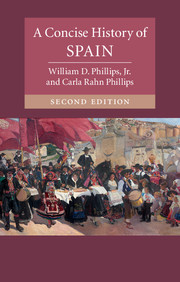Book contents
- Frontmatter
- Contents
- List of illustrations
- List of maps
- Preface
- Note on the second edition
- 1 The land and its early inhabitants
- 2 Ancient legacies
- 3 Diversity in medieval Spain
- 4 The rise of Spain to international prominence
- 5 Spain as the first global empire
- 6 Toward modernity: From the Napoleonic invasion to Alfonso XIII
- 7 The struggle for the Spanish soul: Republic, civil war, and dictatorship
- 8 New Spain, new Spaniards: European, democratic, and multicultural
- Chronology and rulers
- Guide to further information
- Index
- Cambridge Concise Histories
5 - Spain as the first global empire
Published online by Cambridge University Press: 05 December 2015
- Frontmatter
- Contents
- List of illustrations
- List of maps
- Preface
- Note on the second edition
- 1 The land and its early inhabitants
- 2 Ancient legacies
- 3 Diversity in medieval Spain
- 4 The rise of Spain to international prominence
- 5 Spain as the first global empire
- 6 Toward modernity: From the Napoleonic invasion to Alfonso XIII
- 7 The struggle for the Spanish soul: Republic, civil war, and dictatorship
- 8 New Spain, new Spaniards: European, democratic, and multicultural
- Chronology and rulers
- Guide to further information
- Index
- Cambridge Concise Histories
Summary
The administrative structure that the Catholic Monarchs implanted across the Atlantic Ocean laid the basis for the empire that Spain created in the sixteenth century. They improvised that structure from past precedents, responding to the changing situation as Spaniards explored the new lands across the sea. For several centuries Spain also held an empire in Europe, though Spaniards more often referred to the whole collection of diverse territories as a monarchy – lands ruled by a single person. Ironically, Spain's European empire was even more accidental than its American one – the product of bad luck more than conscious planning, as we have seen.
Carlos I was proclaimed king of Spain in Brussels in 1516, ignoring the traditions and prerogatives of the various Spanish kingdoms, and prepared to take up his inheritance. In Spain Cardinal Francisco Ximénez de Cisneros, the driving force behind the reformation of the Spanish church and many aspects of the Spanish Renaissance, performed one last service for the crown by keeping the political situation stable until Carlos arrived in 1517.
Fernando's regency had allowed a generation of explorers to continue tracing the outlines of Castile's New World across the ocean, and Spanish settlers had founded colonies on Hispaniola, Cuba, and various small outposts of the mainland of Central and South America. Whether the embryonic empire would turn out to be profitable remained to be seen. In the meantime, the crown simply gave permission for lands to be explored and settled in its name, but invested little money in the enterprise.
The seventeen-year-old Carlos took great interest in Castile's overseas ventures. Shortly after arriving in Spain, he personally approved a proposal by the Portuguese explorer Ferdinand Magellan to sail westward to Asia to establish a Spanish presence on the far side of the globe. Magellan departed from Spain in 1519 on what would turn out to be the first voyage around the world, but that was not its original aim. Magellan was killed in the Philippines while intervening in a local conflict, and the survivors of the expedition could not find the winds and currents to take them back across the Pacific. Instead, they were forced to return to Spain by sailing around Africa through the half of the world that the Portuguese claimed as their sphere of influence.
- Type
- Chapter
- Information
- A Concise History of Spain , pp. 176 - 272Publisher: Cambridge University PressPrint publication year: 2015

